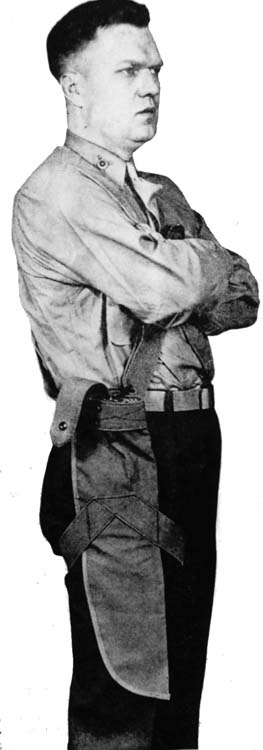
There were a number of accessories and accoutrements manufactured for the Reising guns. Virtually all Reising accessories found today are rare, and generally expensive. The accessories were originally intended for military or police use.
Carrying Cases
There were two types of devices manufactured for the transportation and storage of Reising guns. The first was the hardcase manufactured much like those for the Thompson submachine gun. The Reising cases were made of a black vulcanized fiber, reinforced with metal corners and fittings. The case dimensions were 37 3/8 inches long, 4 5/8 inches wide and 8.5 inches deep and the empty case weighed 13 pounds. The inside of the case provided space for a Reising Model 50 submachine gun, four magazines and two fifty-round boxes of .45 caliber ammunition. The interior of the cases were lined with felt, usually blue in color. A local subcontractor manufactured the hardcases exclusively for Federal Laboratories of Pittsburgh, PA who marketed the cases for police and commercial sales. The original retail cost of the Reising hardcase during 1942 was $16.50. At one time, Reising hardcases were inexpensive. Unfortunately, the situation has changed for those collectors who might desire an original case. Today, when the original cases can be found in mint condition, they command a premium. Most of the hardcases were sold to police departments for storage of the gun and, as it often turned out, the hardcase was a bad choice for long term storage of the weapons because of moisture. Many Reisings that were stored in the cases for many years without attention eventually rusted from dampness that formed inside the case.
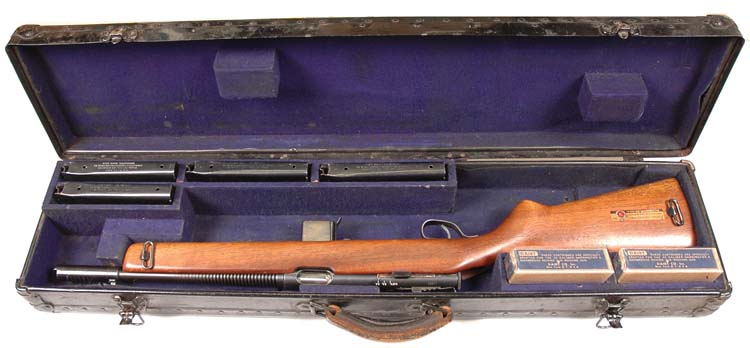
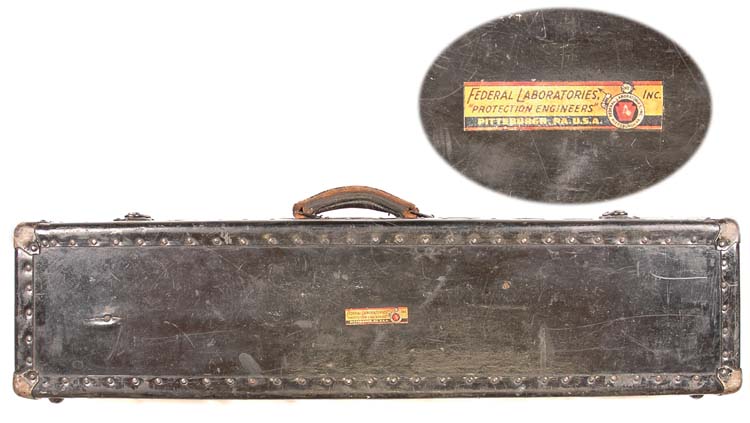
The Canvas Carrying Case
Few of the Reising canvas carrying cases have survived. Offered to police departments in the 1940s by Federal Laboratories, the cases were made from a brown color canvas. The stress areas of the cases were reinforced with light brown leather. Four pockets were provided for storing spare magazines. The flap designed to secure the gun, also covered the magazine pockets. The soft cases were not very popular and are less common than the hardcases.

Military Cases
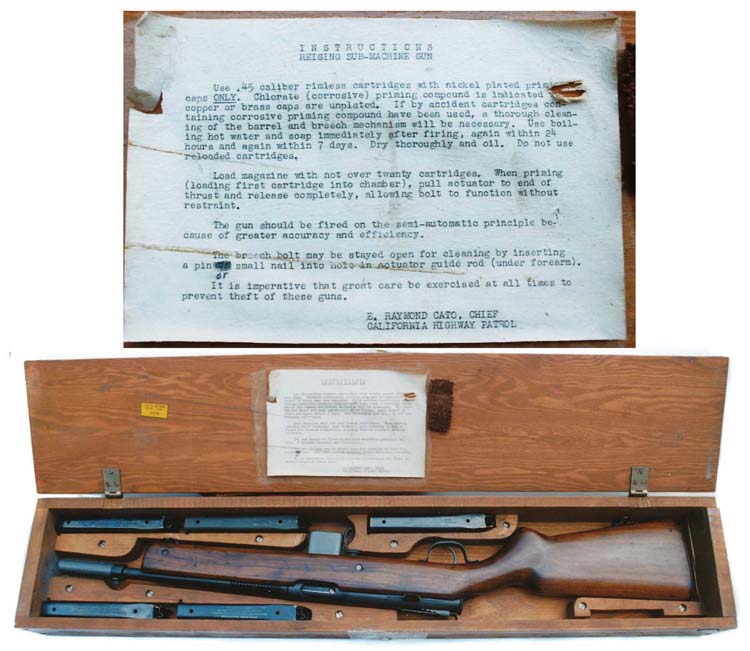
The only known military cases for the Reisings were the ones used by Marine paratroopers. The cases were made in two styles, both for carrying the folding stock Model 55 during a parachute jump. One was a “holster” style case designed for attaching the weapon to the jumper’s leg. The other style, made of canvas with a camouflage pattern, was for carrying the weapon above the reserve chute. There were reports that when the Reising was carried above the reserve chute, the weapon would often strike the jumper in the face when the main chute opened. Both of these cases were manufactured at the U.S. Marine Depot of Supplies in Philadelphia, Pennsylvania.
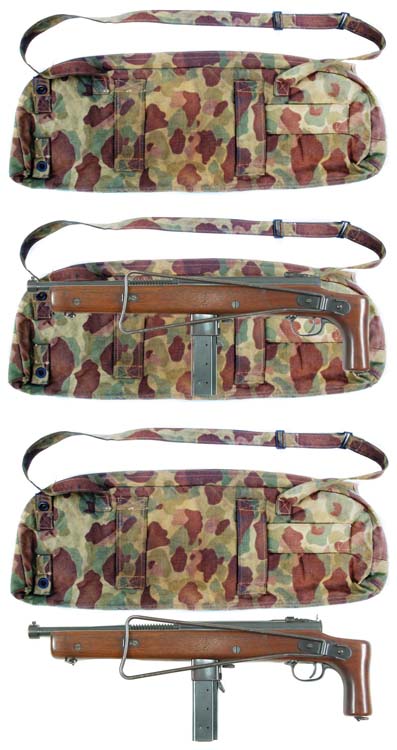
Magazine Pouches
The early commercial magazine pouches were advertised as a “magazine belt” with pockets for carrying spare magazines. There were several types manufactured. One style was designed to hold five twenty-round magazines. This rare pouch had a large single cell for holding the magazines. It had only one flap with two snap type retainers. These pouches were made of dark green color canvas. Another type of commercial magazine pouch had separate pockets for carrying three magazines. This three-cell pouch had separate flaps for each pocket. The flaps were manufactured of light brown canvas, with a dark brown color trim sewn around the outside edge of each flap. The flaps were secured with painted round metal snap-type buttons.
Another magazine pouch manufactured for the Reising was very similar to the military five cell pouches, originally made for carrying the Thompson submachine gun magazines. The Reising pouches were dark green or brown in color and had a separate flap for each of the five cells. Like the aforementioned three cell pouches, the five cell pouches had a different color trim sewn to the outer edge of each flap. The five snaps on this pouch were similar to the military pouch “lift the dot” style snaps. Original commercial Reising magazine pouches are rare.
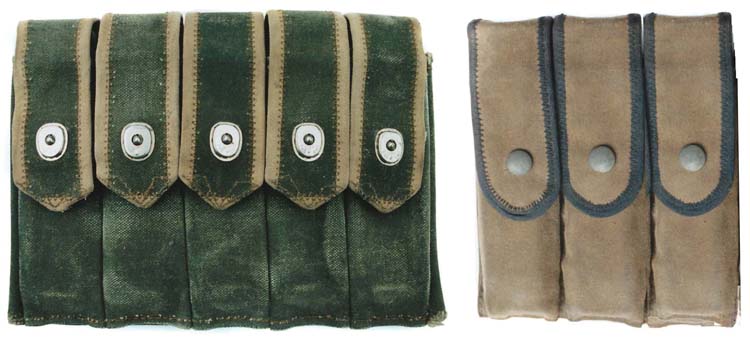
The khaki-colored military issue pouches intended for the Reising magazines were very similar to the common five cell pouches that were issued for carrying the Thompson submachine gun twenty-round magazines. However, the pouches that were issued with the Reising had slightly longer cover flaps and the studs for the snaps were located slightly higher than those on the Thompson pouches. Reising magazines are too long to readily fit into the Thompson pouches, although the 20-round Thompson magazines will fit into a pouch designed for the Reising magazines. It is believed that the original Thompson pouches were reconfigured to be issued with either weapon. Pouches procured by the Marine Corps were manufactured by The Russell Manufacturing Company of Middletown, Connecticut under contract NOm 35935 at a cost of $1.44 each.
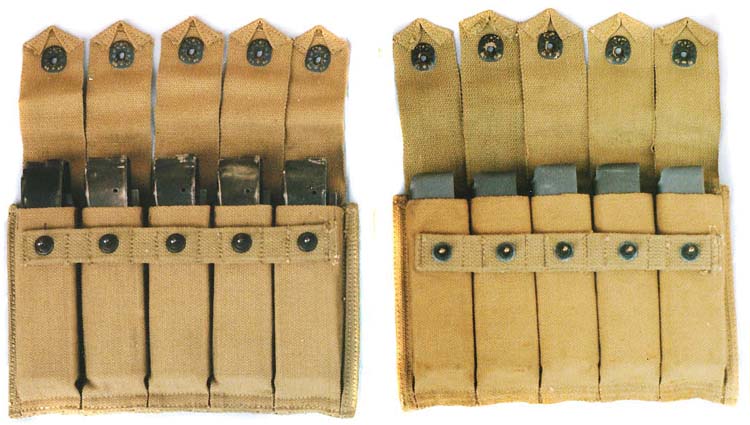
Slings
The very early Reisings that were originally intended for police use were manufactured without any provisions for attaching a carrying sling. In later production, some of the Reisings were fitted with sling swivels, either on the left side of the stock or on the right side. The later “military” style guns had them mounted on the bottom of the stock. The slings intended for use with the Reising were manufactured in two styles. One was a heavy tan leather sling, with brass fittings produced for the police market. The Marines were issued mustard colored slings that resembled the M1 carbine sling. All of the Reising slings that were examined were marked “U.S.M.C. BOYT – 43 -” Boyt being the contractor that manufactured the slings. Although these slings resembled the common carbine sling the space between the snaps was considerably wider. The M1 carbine slings were commonly utilized on the Reisings as well.

Flash Hider
A device intended to conceal the muzzle flash of the Reising when fired at night was mentioned in the early H&R literature. This device was a metal tube that could be slid over the compensator and secured with a small screw. The overall length of the device was nine inches and had a threaded cap on the muzzle end. A short two and one half inch, three piece insert with four carefully spaced, separate baffles was fitted to the inside of the tube. This insert decreased the inside diameter of the tube body. The purpose was to break up and disperse the explosive flashes from a fired cartridge. A patent was filed on July 16, 1942 and Patent 2,356,728 was awarded August 22, 1944. The flash hider was only shown in the very early Reising literature. Although depicted in later parts breakdown photographs, it was not mentioned in the text of later manuals. Apparently there was little market for the device and it was discontinued.
Muzzle Compensator
All Model 50 Reisings were fitted with a compensator or “climb arrester” intended to keep the weapon’s muzzle from rising up when being firing in the full automatic mode. Early literature indicated that the compensator was an option, but all known production M50s and early production Model 55 Reisings were fitted with the device. The Reising compensator was 3.25 inches long and was manufactured from thin .060 inch metal tubing that had six lateral slots cut into the top. The two front slots were longer than the four rear ones. On the front of the compensator, the top half was cut away leaving a half circle shelf on the bottom. The device was internally threaded with 7/8-24 threads and screwed onto the end of the barrel. After the compensator was properly indexed on the barrel it was then center punched at the bottom to secure it in place. A patent was filed on January 6, 1941 for the Reising compensator and Patent number 2,313,669 was granted for the device on March 9,1943. The compensator shown in the patent drawing has fewer slots than the actual production version. The design was similar in design to the Cutts compensator fitted to Thompson submachine guns. The Reising compensator’s effectiveness in controlling muzzle rise was limited. Early Model 55s were fitted with compensators, but the Marines requested that the guns be manufactured without them to keep the overall length of the weapon to a minimum.
Brass Catcher
Federal Laboratory salesman Edward E. Richardson designed a brass catcher for the Reising submachine gun. A patent was filed on June 28, 1943. The device was also designed to be used on the Thompson submachine gun. No examples of the brass catchers are known to exist – only the patent drawing.
Magazines
The .45 caliber magazines produced for the Reising fit the M50, M55 submachine gun models and the semiautomatic Model 60. The magazines were manufactured in a twenty-round and a twelve-round configuration. The magazine body was fabricated from .030 inch sheet metal. The magazine follower and floor plate were also constructed of sheet metal. Some later Reisings had magazine wells that were designed to only accept the twelve-round magazine. The twenty-round magazines were originally blued, and the twelve-round magazines were finished in a colorless Parkerizing.
All original magazines were marked H&R – REISING over MODEL 50 – CAL 45 MAGAZINE over HARRINGTON AND RICHARDSON ARMS CO. over WORCESTER, MASS. USA. Some of the original twelve- and twenty-round magazines have the markings NE-1 numerically ascending up to NE-9 stamped on the front lower portion of the magazine. The NE markings represent the primary contractor of the magazines, the New England Small Arms Corporation (NESA); the dash number represents the magazine contractor or subcontractor. The U.S. Ordnance Department required that all parts and magazines have some type of contractor’s code or marking on them.

The Reising twenty-round capacity magazines were the double stack, single feed design. This design has often come under criticism as being unreliable and susceptible to jamming. These magazines were manufactured for H&R in two slightly different configurations. One version had five holes located on the right side of the magazine. These holes allowed the operator to visually check the number of rounds that were loaded in the magazine; the other style had no holes. Early magazines were finished in a semi gloss blue, while later production had a dull brush blue finish.
The twelve-round magazines, introduced in October of 1942, were designed to fix some of the feeding problems encountered with the earlier twenty-round double stack design. The twelve-round magazines were manufactured with indentations in the bodies to allow the rounds to be stacked in a single row, rather then the double stacked row of the twenty-round magazine. The followers in the twelve-round magazine were flat on the top. After the twelve-round magazine was in production, manufacture of the twenty-round design was terminated. The Marines contracted with H&R to convert all of their existing twenty-round magazines into the twelve-round type at a cost of forty cents each. Some of the late manufactured twelve round magazines have reinforced feed lips.
During the post-war years the twenty-round magazine were no longer mentioned in Reising manuals, advertisements or literature. Many of the Reisings produced in the 1950s were fitted with magazine wells that had an indented rib at the center, which prevented twenty-round magazines from being inserted. The downside of this design is the obvious limited cartridge capacity.
Today, original Reising magazines are expensive when compared to those of similar weapons. The original retail cost of a commercial Reising magazine in 1942 was $2 and the Marine contract price was $1.50.
Dairt “Oilite” .45 Caliber Ammunitionbr
The Dairt ammunition is of interest to Reising collectors because of the statement on the box that reads: “These cartridges are specifically adapted for the .45 caliber Harrington & Richardson Reising Sub-machine gun.” The Dairt Company reloaded spent cartridge cases using special Oilite Bullets made for them by the Amplex Oilite Products Co., a part of the Evansville Chrysler Corporation. Oilite is a sintered, porous, copper alloy impregnated with lubricant. The bullets are one solid piece, having no separate core or jacket. The ammunition was intended for issue to Defense Plant security personnel.
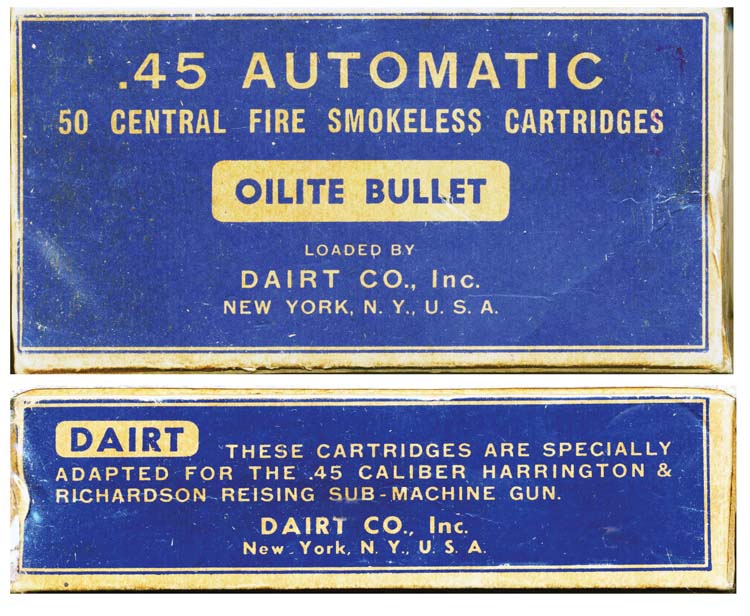
Reproductions
Reproductions of Reising accoutrements have recently appeared on the market. These items (so far) include slings, magazine pouches and H&R marked twenty round magazines. Unfortunately, on occasion, reproduction items are passed off as originals. Most original Reising accessories are over 60 years old and if an item is encountered that looks like it was made yesterday, it probably was.
| This article first appeared in Small Arms Review V14N8 (May 2011) |











